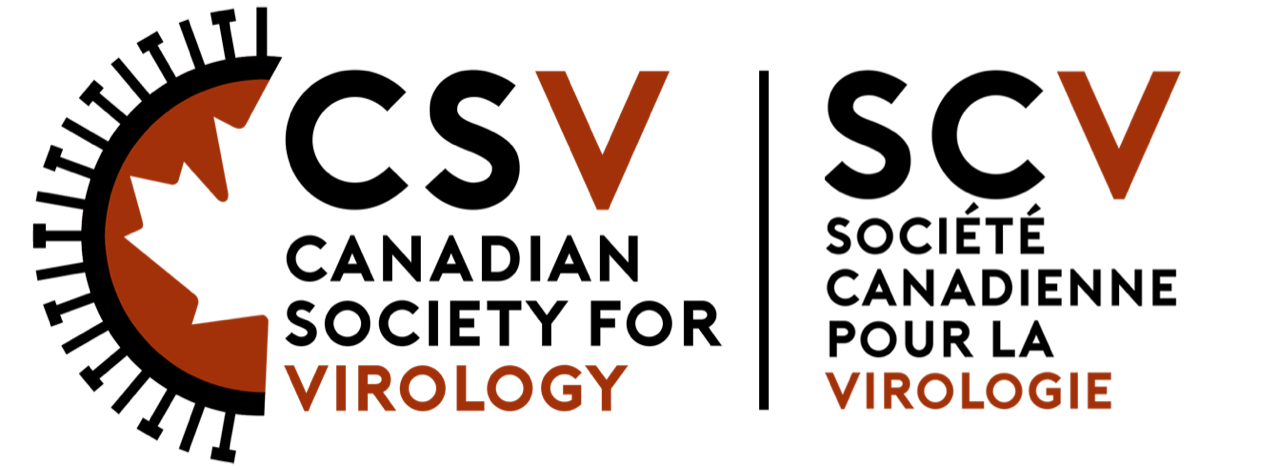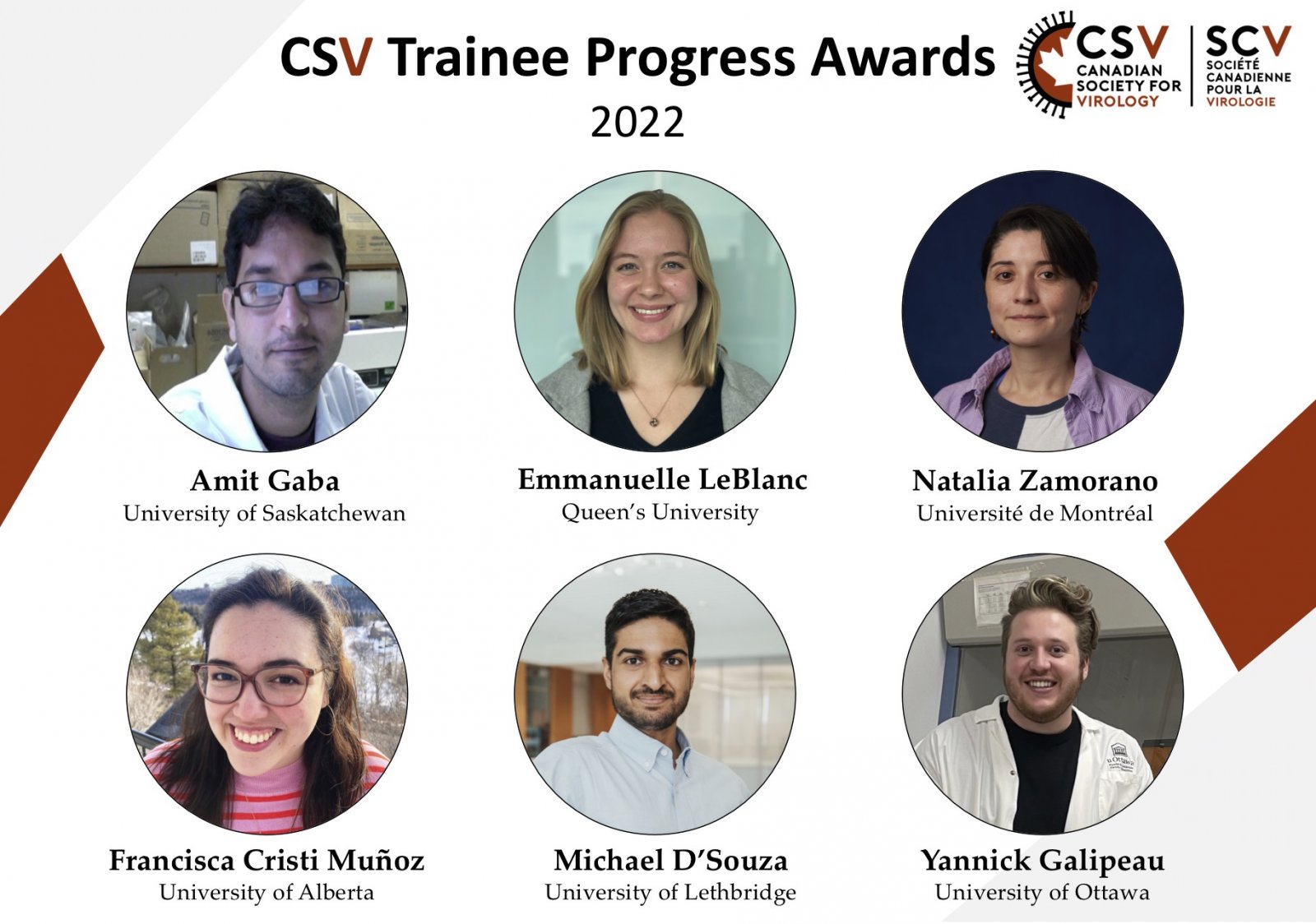
Canadian Society for Virology – Awards Recognizing Outstanding Work by Canadian Virologists and Virology Trainees
Virology is an essential research discipline where discoveries have impacted all areas of biological, environmental, industrial, and clinical science. Canadian scientists are at the cutting edge of critical research discoveries, that have driven the field of virology forward and impacting the international knowledge base. We, the executive committee of the Canadian Society for Virology, have established the CSV Awards to recognize the contributions of Canadians virologists. Together, these awards aim to support virologists at all career stages through recognition of their research, mentoring, and scientific outreach efforts.
2022 Award Winners
Trainee Awards

"Human APOBEC3 enzymes acted as a cross species barrier for simian immunodeficiency virus (SIV) until the SIV Vif protein evolved to antagonize human APOBEC3 enzymes, resulting in HIV-1 and HIV-2. My research has used structure guided experiments to determine how APOBEC3G becomes encapsidated into HIV particles and to characterize artificially evolved more potent APOBEC3 forms. I have also determined that APOBEC3F was the major human cross species barrier for transmission of SIV from Old World Monkeys and that Old World Monkey APOBEC3C is less active than hominid APOBEC3C, suggesting that not all APOBEC3 family members evolved to restrict SIV/HIV."
- Amit Gaba, University of Saskatchewan
"To prepare for future emerging coronaviruses, I am investigating conserved glycan-dependent mechanisms of coronavirus entry and pathogenesis. I am characterizing how glycans on the cell surface or on the coronavirus spike glycoproteins contribute to coronavirus entry. Interestingly, the SARS-CoV-2 spike glycoprotein also activates Toll-like receptor 4 (TLR4), which classically recognizes bacterial lipopolysaccharide, to induce expression of pro-inflammatory cytokines that may contribute to the cytokine storm observed in severe COVID-19. I aim to characterize the roles of glycans in coronavirus entry and TLR4 activation to guide the design of broad-spectrum antivirals targeting these glycan-dependent interactions."
- Emmanuelle LeBlanc, Queen’s University
"I am attempting to understand how reversible oxidation, a type of posttranslational modification occurring on cysteines (Cys ox-PTMs), can modify the structure and function of antiviral cellular hubs activated upon virus infection. We have optimized a particular protocol to perform a proteome wide identification of the Cys ox-PTMs. We identified oxidation of the antiviral adaptor STING at Cys206, which plays an inhibitory role to prevent STING hyperactivation through the formation of inactive polymers. I am currently working on other antiviral proteins which activity seems to be regulated by this type of modification."
- Natalia Zamorano, Université de Montréal
"Oncolytic reovirus is a promising anti-cancer therapy but requires improvement. We propose that genetic modifications of reovirus will increase its oncolytic potency. Consequently, I created an improved reovirus mutant called Super Virus 5 (SV5). When evaluated in animal experiments, SV5 reduced breast tumor growth and improved the survival of mice relative to wild-type reovirus. Currently, I am investigating why SV5 is a better oncolytic virus. Surprisingly, I have found that SV5 does not replicate faster than wild-type reovirus, but it seems to spread better. Together, my doctoral project will reveal new approaches to improve reovirus as a breast cancer therapy."
- Francisca Cristi Muñoz, University of Alberta
"Emerging zoonotic viruses can cause devastating outbreaks and indelible economic repercussions to human systems. Hantavirus is a NIAID Category A Priority Pathogen whose spread is increasing through climate change and anthropogenic activity. Hantaviral Noncoding Terminal Regions (NTRs) regularly instigate viral replication and translation, while also regulating viral encapsidation and trafficking. My research seeks to identify human RNA-Binding Proteins involved in Hantaviral lifecycles through Pull-Down Assays. We have identified several RNA stabilising and salient viral lifecycle promoting proteins that putatively interact with these NTRs. We have also biophysically characterised the NTRs using Small Angle X-ray Scattering and Multiangle/Dynamic Light Scattering techniques."
- Michael D’Souza, University of Lethbridge
"The emergence of SARS-CoV-2 has resulted in a pandemic with multiple waves of infection in Canada. In March 2020, I started the development of SARS-CoV-2 specific serological assays, an important step towards understanding humoral responses following natural infection and immunization. This was closely followed by developing one of the largest high-throughput SARS-CoV-2 serological platform in Canada, now supporting over 30 studies nationally. In addition, I have assessed the seroprevalence of seasonal coronavirus in Canada and their cross-reactivity to SARS-CoV-2. My main research interest now includes understanding the impact of variants of concerns, long term immunity and post-acute sequalae of SARS-CoV-2."
- Yannick Galipeau, University of Ottawa
